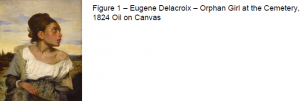Drew Rane and Professor Peter Everett, Studio Arts
The paintings of Eugene Delacroix show an exception power and emotion. Delacroix uses the human figure and color in order to express emotion. There continues to be an important place for the use of representation of the human figure in contemporary art. This is through the expressive quality that avails itself through use of the figure. Though the widespread popularity of the human figure in art waxes and wanes there continues to be a need filled by the figure. The representation varies widely from traditional academic accurate representation to an abstracted form to an even more distanced use with contemporary video work making reference to a human form. Through my own work I have found the need to implement the figure. This is because the human figure instills a response in the viewer, the representation of another human supplies a connection to the broader world. My desire to study Delacroix came because he was a master of using the figure in order to express different emotions and initiate responses. Although through the research took me beyond the use of the figure and into color, the human figure is what initiated and drove my work.
By being on site to see the works I was able to have an accurate view of the color. I was able to view the works on their scale, which allowed me to experience the emotion and power of each painting. The size and types of paintings varied widely from 25ft tall frescos to 15ft wide oil paintings to small sketchbook drawings. Delacroix kept an extensive journal for much of his life, which is one of the most influential texts that have been written by an artist. This journal provided a gateway into the thoughts of the artist and a deeper explanation of the work. It provided confirming accounts for the ideas that Delacroix was approaching. Although I primarily used the art works themselves as my reference, his writings provided a valuable expansion. I was able to spend hours in front of the original works and I was able to make copies of paintings in addition to making my own paintings with the applied knowledge from studying Delacroix’s paintings.
Through my research I discovered that Eugene Delacroix firstly used color in order to express his ideas. Although Delacroix shows immense emotion through his use of the figure, the lasting and influential value lies in the use of color. The most important element is the visual impact that the study had on my paintings. Being influenced by Delacroix has changed my paintings, by decreasing the use of the contour, and greatly affecting my capacity to use color. Delacroix wrote that “ The contour should come last, only a very experienced eye can place it rightly” (Delacroix, 1980).
The emphasis is on strong brushstrokes rather than the contour. The refined drawing became less important and contour became less necessary and even a detractor from the work. The rejection of line in favor of color does not insist on bright colors or even a wide-ranging pallet. The influence of Eugene Delacroix extends past the expressive and masterful use of the figure, in extends to a brilliant use of color. This color usage is a continuation of the rich tradition of expressive and emotion uses of paint.
Color and drawing have been on opposite sides of the argument, with the heritage of those contending for color extending back to Michelangelo Buonarroti as a predecessor and after Delacroix, Willem De Kooning is a continuation and advancer of those ideas. These are important principles that extend beyond specific styles or periods. Delacroix was a gateway and an advancer of what eventually became championed in modern art, which was color over form. Delacroix was a master at the use of color and of the human figure to create expressive works.
Reference
- Delacroix, E., & Wellington, H. (1980). The journal of Eugène Delacroix: A selection (p. XXIV). Ithaca, N.Y.: Cornell University Press



